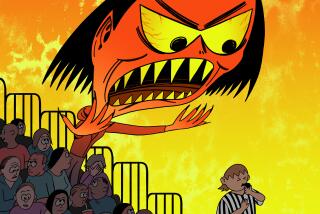Tips on Preventing Sports Injuries to Youngsters : Health: Before a child starts any athletic program, parents should find out how students are chosen and what the physical requirements are.
- Share via
It even sounds painful: helmet cracking against helmet, linemen grunting, the thud of bodies landing in a pile.
But that doesn’t mean Junior should be locked in the library if he comes home with a football helmet. A student-athlete is about as likely to sustain a serious injury in wrestling as in football, and more likely in gymnastics. And parents can play an important role in preventing many sports-related injuries.
“Parents have an obligation to find out what coaches expect,” said John Lopez, former athletic trainer for the Baltimore Colts and now director of the Towson Sports Medicine Center. “That’s the most important thing you can do.”
Lopez and other specialists say they see a surprising number of serious injuries as well as sprains, pulled muscles and overused joints that might have been avoided through better conditioning, stronger communication between parents and coach, and proper treatment when an injury occurs.
“Kids who get hurt and get mismanaged can have a semi-crippling injury at a very young age,” Lopez cautioned.
Before a child starts any sports program, parents should find out how students are chosen and what the physical requirements will be. Young children who play in Pop Warner youth football or Little League baseball usually don’t risk much injury as long as they play with children near their own size, said Neil McDonald, director of the Union Memorial Sports Medicine Center.
“Young kids don’t run fast enough and aren’t heavy enough to cause serious injuries,” said McDonald, whose center treats 4,000 athletes a year.
But when they reach the junior high and high school levels, sports become more competitive, and students must be committed to the program to succeed. That should mean year-round conditioning, even for activities such as swimming. Overall strengthening can prevent common injuries to the knees and other joints that take a pounding in many sports.
“I think the most significant movement in the ‘70s and ‘80s has been strengthening,” said Dr. Norman B. Rosen of Rehabilitation and Pain Management Associates of Baltimore. “In the past, we wouldn’t put a swimmer, pitcher or dancer in strengthening programs.”
Once a child chooses a sport, parents should introduce themselves to the coach and get a feel for his or her attitude.
Is this someone who will teach your child about athletics, without being overly concerned about the team’s win-loss record? Does the coach feel prepared to deal with injuries, about 60% of which happen during practice?
Also find out about the coach’s feeling on warm-ups and water breaks, and make sure your child gets some outdoor exercise during the summer.
In the past, some coaches jumped right into full practices in August for fall sports, and even frowned on water breaks. Now it’s well known that the most serious injuries, even death, can occur when an athlete is overheated and dehydrated. Children are also more susceptible to heat illness than adults, said Dr. Modena Wilson of the Johns Hopkins Children’s Center.
Says Lopez: “If Billy’s been sitting in front of the television in the air conditioning eating Twinkies, they have to realize he’s not going to be in shape to play soccer.”
Dr. Marshall K. Steele, an orthopedic surgeon with the Orthopaedic and Sports Medicine Center of Annapolis and team physician for Annapolis High School, said a coach should be aware that it takes about three weeks for athletes to become acclimatized to the heat.
It’s also important, he said, for parents to get their children to practice in time for the warm-up so they don’t jump right into strenuous activity.
The coach also should provide water breaks at least every 45 minutes and make sure the athletes feel comfortable getting water at any time.
“He (the coach) has to provide the kids with the freedom to stop and get water and sit down,” Steele said. “Most kids will consider that defeat. It’s the coach’s responsibility to make kids feel comfortable (getting water) or to provide rest periods.”
Because of the possibility of heat-related deaths in football--it happens almost every year somewhere in the country--schools should weigh athletes before and after each morning and afternoon practice, McDonald said.
If an athlete loses more than 2% of his or her weight in a morning practice and doesn’t gain it back through fluid intake before the afternoon session, he or she shouldn’t be allowed to play, McDonald said.
“There should be no limit as to how much water kids drink,” he said.
Though high school football still sees the greatest number of deaths or catastrophic injuries--a nationwide average of 24 a year--other field sports such as soccer, field hockey and lacrosse are becoming more popular, and therefore more competitive and more likely to produce injuries, experts say.
At the beginning of the season, the most common injuries are pulled muscles and strains. At the end of the year, it’s overuse injuries such as tendinitis, bursitis and shin splints.
Parents can help to prevent many injuries by making sure playing fields are groomed properly, Dr. Wilson said. “Unevenness is responsible for a lot of injuries,” she said.
If an injury does occur, area experts say it’s not unusual for parents to take their child to the family pediatrician, who may or may not be familiar with sports injuries.
But experts say teen-agers should see an orthopedist or sports medicine specialist. If the injury isn’t treated properly, the athlete suffers the risk of getting reinjured and seriously limiting his ability to play sports.
Problems can also arise when gifted athletes are overused because their performances can make or break a team’s win-loss record. McDonald uses the example of young baseball pitchers whose coaches are too enamored of their talent to take them out of the game when they need to rest. A student-athlete who wants to compete is highly unlikely to make that decision himself, he said.
“When you’re born, you’ve got only so many miles to run, so many pitches in your arm,” he said. “A lot of these kids, by the time they reach 18, 19, 20, have either been coached improperly or have thrown their arm out.”
Another problem is emotional burnout, which may lead to injury if the athlete is tired or uninterested in the game. Preventing such injuries means parents should make sure a sports activity is fun for their child, not just for them.
“We probably get a dozen kids a year who ask, ‘Can you tell my mom and dad I’m hurt and I don’t have to play?’ ” McDonald said.
More to Read
Go beyond the scoreboard
Get the latest on L.A.'s teams in the daily Sports Report newsletter.
You may occasionally receive promotional content from the Los Angeles Times.










